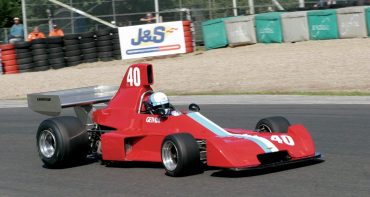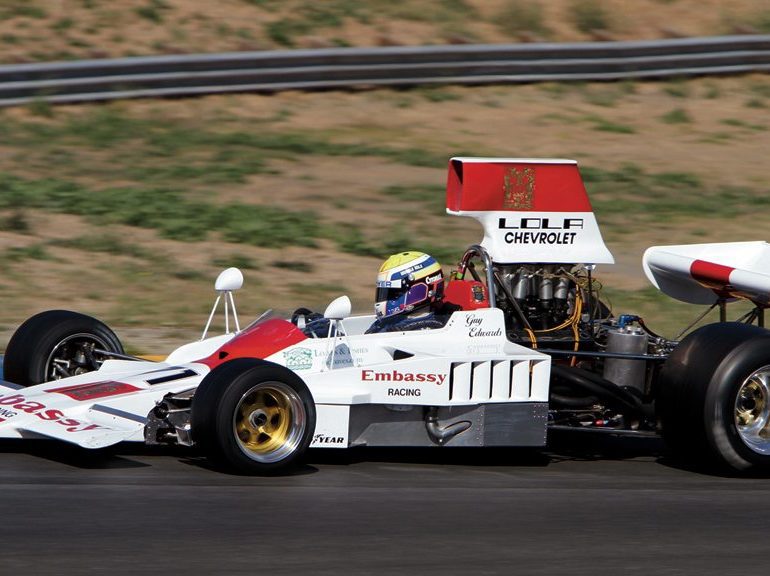Formula 5000 was a racing series for open-wheel, single-seat racing cars built to a specific set of rules. The engine of choice was the venerable small block Chevrolet V8 of 5-liter displacement. It started as a bright idea in 1967 and ran successfully until politics between the governing body, race organizers and team owners did it in at the end of the 1976 season.
Although there were four competitive Formula 5000 championships: the Rothmans series in Europe, the Tasman series in Australia and New Zealand, and the Tarmac series in Britain, the heart and soul of Formula 5000 was the North American series. In the early 1970s it was known as the L&M Championship after title sponsor L&M tobacco. In 1974, the SCCA and rival governing body USAC merged to run Formula 5000. A variety of chassis manufacturers took part, but the car that dominated the later years of the series was the Lola T332. Even though the rules allowed the turbocharged Offenhauser engine to run, the engine that dominated the series was Chevrolet’s 5-liter V8, which could put out a reliable 550 bhp and 425 lbs-ft of torque at 8,000 rpm. In fact, it would have been an all-Chevrolet victory season if not for Jackie Oliver winning two races in a Dodge V8-powered Shadow DN6.
Even though many top drivers such as Mario Andretti, Mark Donohue, David Hobbs, James Hunt, Alan Jones, Jackie Oliver, Jody Scheckter and Al Unser took part, the dominant driver one associates with Formula 5000 is Brian Redman, who won the championship in 1974, 1975 and 1976.
Today, Formula 5000 cars represent a lot of racing performance for one’s money. One of the most important factors in determining current market value is the cost and quality of the restoration. It is also important to note that currently, in New Zealand, Australia, and Great Britain, F5000 cars have a greater following than in America and, therefore, command a greater value. This, combined with currency rates, import duties, and VAT, can create a 25-35 percent premium in the estimated value of vehicles in these countries.
| Make | Model | Acceptance | Level III | Level II | Level I |
| Begg | FM2,FM4,FM5 | 3 | $65,000 | $80,000 | $110,000 |
| Caldwell | D8 | 3 | $60,000 | $75,000 | $100,000 |
| Chevron | B24 | 3 | $80,000 | $100,000 | $135,000 |
| B28 | 3 | $80,000 | $100,000 | $135,000 | |
| B30 | 3 | $80,000 | $100,000 | $135,000 | |
| B37 | 3 | $80,000 | $100,000 | $135,000 | |
| Cooper | T90 | 3 | $60,000 | $80,000 | $95,000 |
| Crossle | 15F | 3 | $60,000 | $80,000 | $100,000 |
| Eagle | 1968 | 3 | $60,000 | $85,000 | $110,000 |
| A73 | 3 | $70,000 | $110,000 | $135,000 | |
| 755 | 3 | $80,000 | $115,000 | $145,000 | |
| Elfin | MR5, 6, 8, 9 | 3 | $75,000 | $110,000 | $125,000 |
| Leda | LT20, 22, 25 | 3 | $70,000 | $95,000 | $120,000 |
| LeGrand | Mk7 | 3 | $45,000 | $65,000 | $75,000 |
| Lola | T140-142 | 3 | $55,000 | $75,000 | $90,000 |
| T190 | 3 | $60,000 | $75,000 | $100,000 | |
| T191, 192 | 3 | $60,000 | $75,000 | $100,000 | |
| T300 | 3 | $70,000 | 100,000 | $125,000 | |
| T330, 332 | 3 | $85,000 | $125,000 | $165,000 | |
| T400 | 3 | $80,000 | $120,000 | $145,000 | |
| Lotus | 70 | 3 | $75,000 | $115,000 | $140,000 |
| March | 73A | 3 | $70,000 | $95,000 | $115,000 |
| 74A, 75A, 76A | 3 | $75,000 | $110,000 | $140,000 | |
| McKee | Mk8 | 3 | $60,000 | $85,000 | $100,000 |
| Mk12, 18 | 3 | $60,000 | $85,000 | $100,000 | |
| McLaren | M10A, B | 3 | $75,000 | $110,000 | $140,000 |
| M18 | 3 | $75,000 | $110,000 | $140,000 | |
| M22 | 3 | $75,000 | $125,000 | $145,000 |
| Make | Model | Acceptance | Level III | Level II | Level I |
| McRae | GM1 | 3 | $75,000 | $110,000 | $135,000 |
| Shadow | DN6 | 3 | $75,000 | $100,000 | $125,000 |
| Spectre | HR-1 | 3 | $55,000 | $75,000 | $90,000 |
| Surtees | TS5, TS8 | 3 | $65,000 | $85,000 | $110,000 |
| TS11 | 3 | $70,000 | $90,000 | $115,000 | |
| Talon | MR1 | 3 | $60,000 | $80,000 | $105,000 |
| Trojan | T101 | 3 | $75,000 | $100,000 | $115,000 |
1976 Chevron B37

1974 Lola T332

By the early 1970s Eric Broadley’s Lola Cars, of Huntingdon, England, was well-respected for building successful sports racing and single-seater racing cars. They had won the Can-Am Championship, raced at Le Mans and were successful in various single-seater categories. Lola’s foremost venture into the Formula 5000 series started with the 1971 T300. Then the 1973 T330 and the evolution of that car, the 1974 T332, which was the most successful Formula 5000 car produced. The T332 had an aluminum monocoque with the engine used as a stressed member. The aerodynamics were improved by the use of a big rear wing. The front suspension was double wishbone, while the rear had transverse top links and lower wishbones with radius rods. Lockheed ventilated discs were fitted outboard at the front and inboard at the rear. The engine was the Chevrolet V8 and the gearbox the Hewland DG300. The T332 weighed in at under 1,400 lbs, handled extremely well and went on to win numerous races. Some of the drivers included Brian Redman, Mario Andretti, David Hobbs and Jody Scheckter. The T332 is still the F5000 car to have today.
Criteria Used For Assessing Valuations for this Guide:
- Degree of Originality
- Overall Condition, Restoration
- Technology, Design, Coachbuilder
- Production Numbers/Rarity
- Competition History
- Ownership History, Documentation
- Modern Event Eligibility
Regional Variances
The prices stated in this guide are based on U.S. values. The values of historic racing cars can vary as much as 25%-35% in other countries, depending on local market appeal, currency rates, import duties, and VAT. Most of the time, we are able to document known sales or closed escrows, as they say in real estate. When this is not possible, a logical estimate of the car’s value is given, based on its sales history and relationship to cars of its type.
The prices stated in this guide are based on U.S. values. The values of historic racing cars can vary as much as 25%-35% in other countries, depending on local market appeal, currency rates, import duties, and VAT.
LEVEL |
VALUATION CATEGORIES |
|---|---|
I |
The best combination of all criteria. |
II |
Satisfies mid-range of criteria. |
III |
In need of restoration. Meets only a few points of criteria |




